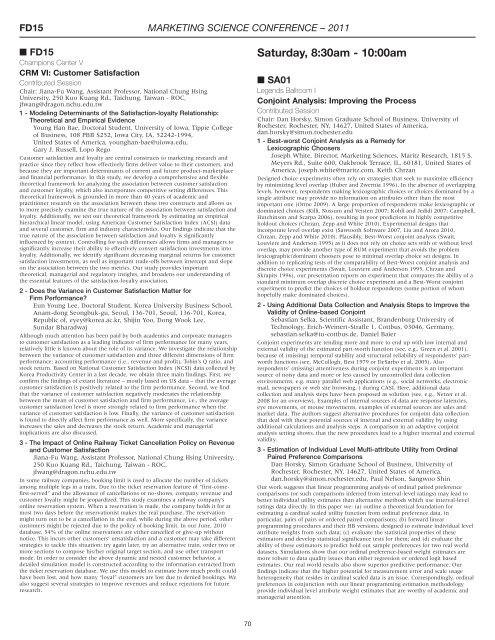Conference Sessions - Jesse H. Jones Graduate School of ...
Conference Sessions - Jesse H. Jones Graduate School of ...
Conference Sessions - Jesse H. Jones Graduate School of ...
Create successful ePaper yourself
Turn your PDF publications into a flip-book with our unique Google optimized e-Paper software.
FD15<br />
■ FD15<br />
Champions Center V<br />
CRM VI: Customer Satisfaction<br />
Contributed Session<br />
Chair: Jiana-Fu Wang, Assistant Pr<strong>of</strong>essor, National Chung Hsing<br />
University, 250 Kuo Kuang Rd., Taichung, Taiwan - ROC,<br />
jfwang@dragon.nchu.edu.tw<br />
1 - Modeling Determinants <strong>of</strong> the Satisfaction-loyalty Relationship:<br />
Theoretical and Empirical Evidence<br />
Young Han Bae, Doctoral Student, University <strong>of</strong> Iowa, Tippie College<br />
<strong>of</strong> Business, 108 PBB S252, Iowa City, IA, 52242-1994,<br />
United States <strong>of</strong> America, younghan-bae@uiowa.edu,<br />
Gary J. Russell, Lopo Rego<br />
Customer satisfaction and loyalty are central constructs to marketing research and<br />
practice since they reflect how effectively firms deliver value to their customers, and<br />
because they are important determinants <strong>of</strong> current and future product-marketplace<br />
and financial performance. In this study, we develop a comprehensive and flexible<br />
theoretical framework for analyzing the association between customer satisfaction<br />
and customer loyalty, which also incorporates competitive setting differences. This<br />
theoretical framework is grounded in more than 40 years <strong>of</strong> academic and<br />
practitioner research on the association between these two constructs and allows us<br />
to more precisely examine the true nature <strong>of</strong> the association between satisfaction and<br />
loyalty. Additionally, we test our theoretical framework by estimating an empirical<br />
hierarchical linear model, using American Customer Satisfaction Index (ACSI) data<br />
and several customer, firm and industry characteristics. Our findings indicate that the<br />
true nature <strong>of</strong> the association between satisfaction and loyalty is significantly<br />
influenced by context. Controlling for such differences allows firms and managers to<br />
significantly increase their ability to effectively convert satisfaction investments into<br />
loyalty. Additionally, we identify significant decreasing marginal returns for customer<br />
satisfaction investments, as well as important trade-<strong>of</strong>fs between intercept and slope<br />
on the association between the two metrics. Our study provides important<br />
theoretical, managerial and regulatory insights, and broadens our understanding <strong>of</strong><br />
the essential features <strong>of</strong> the satisfaction-loyalty association.<br />
2 - Does the Variance in Customer Satisfaction Matter for<br />
Firm Performance?<br />
Eun Young Lee, Doctoral Student, Korea University Business <strong>School</strong>,<br />
Anam-dong Seongbuk-gu, Seoul, 136-701, Seoul, 136-701, Korea,<br />
Republic <strong>of</strong>, eyey@korea.ac.kr, Shijin Yoo, Dong Wook Lee,<br />
Sundar Bharadwaj<br />
Although much attention has been paid by both academics and corporate managers<br />
to customer satisfaction as a leading indicator <strong>of</strong> firm performance for many years,<br />
relatively little is known about the role <strong>of</strong> its variance. We investigate the relationship<br />
between the variance <strong>of</strong> customer satisfaction and three different dimensions <strong>of</strong> firm<br />
performance: accounting performance (i.e., revenue and pr<strong>of</strong>it), Tobin’s Q ratio, and<br />
stock return. Based on National Customer Satisfaction Index (NCSI) data collected by<br />
Korea Productivity Center in a last decade, we obtain three main findings. First, we<br />
confirm the findings <strong>of</strong> extant literature – mostly based on US data – that the average<br />
customer satisfaction is positively related to the firm performance. Second, we find<br />
that the variance <strong>of</strong> customer satisfaction negatively moderates the relationship<br />
between the mean <strong>of</strong> customer satisfaction and firm performance, i.e., the average<br />
customer satisfaction level is more strongly related to firm performance when the<br />
variance <strong>of</strong> customer satisfaction is low. Finally, the variance <strong>of</strong> customer satisfaction<br />
is found to directly affect firm performance as well. More specifically, the variance<br />
increases the sales and decreases the stock return. Academic and managerial<br />
implications are also discussed.<br />
3 - The Impact <strong>of</strong> Online Railway Ticket Cancellation Policy on Revenue<br />
and Customer Satisfaction<br />
Jiana-Fu Wang, Assistant Pr<strong>of</strong>essor, National Chung Hsing University,<br />
250 Kuo Kuang Rd., Taichung, Taiwan - ROC,<br />
jfwang@dragon.nchu.edu.tw<br />
In some railway companies, booking limit is used to allocate the number <strong>of</strong> tickets<br />
among multiple legs in a train. Due to the ticket reservation feature <strong>of</strong> “first-comefirst-served”<br />
and the allowance <strong>of</strong> cancellations or no-shows, company revenue and<br />
customer loyalty might be jeopardized. This study examines a railway company’s<br />
online reservation system. When a reservation is made, the company holds it for at<br />
most two days before the reservationist makes the real purchase. The reservation<br />
might turn out to be a cancellation in the end, while during the above period, other<br />
customers might be rejected due to the policy <strong>of</strong> booking limit. In our June, 2010<br />
database, 54% <strong>of</strong> the online reservations are either cancelled or give-up without<br />
notice. This incurs other customers’ unsatisfaction and a customer may take different<br />
strategies to tackle this situation: try again later, try an alternative train, order two or<br />
more sections to compose his/her original target section, and use other transport<br />
mode. In order to consider the above dynamic and nested customer behavior, a<br />
detailed simulation model is constructed according to the information extracted from<br />
the ticket reservation database. We use this model to estimate how much pr<strong>of</strong>it could<br />
have been lost, and how many “loyal” customers are lost due to denied bookings. We<br />
also suggest several strategies to improve revenues and reduce rejections for future<br />
research.<br />
MARKETING SCIENCE CONFERENCE – 2011<br />
70<br />
Saturday, 8:30am - 10:00am<br />
■ SA01<br />
Legends Ballroom I<br />
Conjoint Analysis: Improving the Process<br />
Contributed Session<br />
Chair: Dan Horsky, Simon <strong>Graduate</strong> <strong>School</strong> <strong>of</strong> Business, University <strong>of</strong><br />
Rochester, Rochester, NY, 14627, United States <strong>of</strong> America,<br />
dan.horsky@simon.rochester.edu<br />
1 - Best-worst Conjoint Analysis as a Remedy for<br />
Lexicographic Choosers<br />
Joseph White, Director, Marketing Sciences, Maritz Research, 1815 S.<br />
Meyers Rd., Suite 600, Oakbrook Terrace, IL, 60181, United States <strong>of</strong><br />
America, joseph.white@maritz.com, Keith Chrzan<br />
Designed choice experiments <strong>of</strong>ten rely on strategies that seek to maximize efficiency<br />
by minimizing level overlap (Huber and Zwernia 1996). In the absence <strong>of</strong> overlapping<br />
levels, however, respondents making lexicographic choices or choices dominated by a<br />
single attribute may provide no information on attributes other than the most<br />
important one (Orme 2009). A large proportion <strong>of</strong> respondents make lexicographic or<br />
dominated choices (Killi, Nossum and Veisten 2007; Kohli and Jedidi 2007; Campbell,<br />
Hutchinson and Scarpa 2006), resulting in poor predictions in highly competitive<br />
holdout choices (Chrzan, Zepp and White 2010). Experimental designs that<br />
incorporate level overlap exist (Sawtooth S<strong>of</strong>tware 2007, Liu and Arora 2010,<br />
Chrzan, Zepp and White 2010). Plausibly, Best-Worst conjoint analysis (Swait,<br />
Louviere and Anderson 1995) as it does not rely on choice sets with or without level<br />
overlap, may provide another type <strong>of</strong> RUM experiment that avoids the problem<br />
lexicographic/dominant choosers pose to minimal overlap choice set designs. In<br />
addition to replicating tests <strong>of</strong> the comparability <strong>of</strong> Best-Worst conjoint analysis and<br />
discrete choice experiments (Swait, Louviere and Anderson 1995, Chrzan and<br />
Skrapits 1996), our presentation reports an experiment that compares the ability <strong>of</strong> a<br />
standard minimum overlap discrete choice experiment and a Best-Worst conjoint<br />
experiment to predict the choices <strong>of</strong> holdout respondents (some portion <strong>of</strong> whom<br />
hopefully make dominated choices).<br />
2 - Using Additional Data Collection and Analysis Steps to Improve the<br />
Validity <strong>of</strong> Online-based Conjoint<br />
Sebastian Selka, Scientific Assistant, Brandenburg University <strong>of</strong><br />
Technology, Erich-Weinert-Strafle 1, Cottbus, 03046, Germany,<br />
sebastian.selka@tu-cottbus.de, Daniel Baier<br />
Conjoint experiments are tending more and more to end up with low internal and<br />
external validity <strong>of</strong> the estimated part-worth function (see, e.g., Green et al. 2001),<br />
because <strong>of</strong> (missing) temporal stability and structural reliability <strong>of</strong> respondents’ partworth<br />
functions (see, McCullogh, Best 1979 or DeSarbo et al. 2005). Also<br />
respondents’ (missing) attentiveness during conjoint experiments is an important<br />
source <strong>of</strong> noisy data and more or less caused by uncontrolled data collection<br />
environments, e.g. many parallel web applications (e.g., social networks, electronic<br />
mail, newspapers or web site browsing, ) during CASI. Here, additional data<br />
collection and analysis steps have been proposed as solution (see, e.g., Netzer et al.<br />
2008 for an overview). Examples <strong>of</strong> internal sources <strong>of</strong> data are response latencies,<br />
eye movements, or mouse movements, examples <strong>of</strong> external sources are sales and<br />
market data. The authors suggest alternative procedures for conjoint data collection<br />
that deal with these potential sources <strong>of</strong> internal and external validity by using<br />
additional calculations and analysis steps. A comparison in an adaptive conjoint<br />
analysis setting shows, that the new procedures lead to a higher internal and external<br />
validity.<br />
3 - Estimation <strong>of</strong> Individual Level Multi-attribute Utility from Ordinal<br />
Paired Preference Comparisons<br />
Dan Horsky, Simon <strong>Graduate</strong> <strong>School</strong> <strong>of</strong> Business, University <strong>of</strong><br />
Rochester, Rochester, NY, 14627, United States <strong>of</strong> America,<br />
dan.horsky@simon.rochester.edu, Paul Nelson, Sangwoo Shin<br />
Our work suggests that linear programming analysis <strong>of</strong> ordinal paired preference<br />
comparisons (or such comparisons inferred from interval-level ratings) may lead to<br />
better individual utility estimates than alternative methods which use interval-level<br />
ratings data directly. In this paper we: (a) outline a theoretical foundation for<br />
estimating a cardinal scaled utility function from ordinal preference data, in<br />
particular, pairs <strong>of</strong> pairs or ordered paired comparisons; (b) forward linear<br />
programming procedures and their HB versions, designed to estimate individual level<br />
attribute weights from such data; (c) evaluate the statistical properties <strong>of</strong> these<br />
estimators and develop statistical significance tests for them; and (d) evaluate the<br />
ability <strong>of</strong> these estimators to predict hold out sample preferences for two real world<br />
datasets. Simulations show that our ordinal preference-based weight estimates are<br />
more robust to data quality issues than either regression or ordered logit based<br />
estimates. Our real world results also show superior predictive performance. Our<br />
findings indicate that the higher potential for measurement error and scale usage<br />
heterogeneity that resides in cardinal scaled data is an issue. Correspondingly, ordinal<br />
preferences in conjunction with our linear programming estimation methodology<br />
provide individual level attribute weight estimates that are worthy <strong>of</strong> academic and<br />
managerial attention.

















